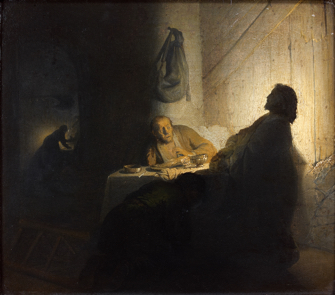
The title of the exhibition “Rembrandt Intime” at the Musée Jacquemart-André is slightly misleading; although the show does include a number of the artist’s self-portraits (he made around 80) and paintings featuring family members, it goes well beyond the intimate life of Rembrandt van Rijn (1606-69),
No matter. Rembrandt is Rembrandt, and it is always a joy to look at his work in the flesh, so to speak. This show (through Jan. 23), a small feast of his paintings, is built around three works acquired by the museum’s founders, 19th-century collectors Édouard André and Nélie Jacquemart: “Pilgrims at Emmaus” (1629), “Portrait of Princess Amalia van Solms” (1632), and “Portrait of Doctor Arnold Tholinx” (1656).
The first room of paintings from his youth offers a few notable self-portraits, including a 1633 selfie belonging to the Louvre, in which the 27-year-old artist, with a wispy moustache and longish curly red hair, stares out of the canvas with a serious, concentrated expression and a deep frown line on his forehead. A gold necklace, a symbol of high status, gleams against the dull reddish-brown of his robe.
In “Self-portrait in Oriental Attire” (1631-33), Rembrandt, dressed in a gleaming bronze-colored robe and black cloak, wears a smile
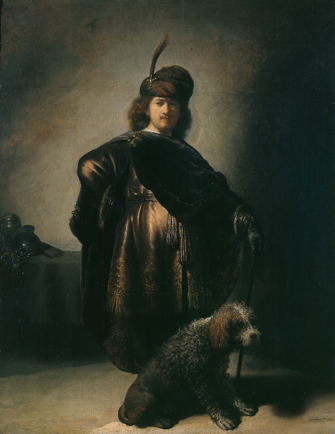
as resigned as the pose of the poodle at his feet, whose curly hair looks much like the artist’s. The dog was apparently an afterthought, added by Rembrandt to hide his legs, which he seems to have been unhappy with (X-rays show that he first changed them before adding the dog).
In an amusing onscreen presentation, Rembrandt morphs from youth to old age in his self-portraits with the help of modern technology. Most interesting in the first room, however, are two early paintings obviously influenced by his master, Peter Lastman. They don’t look at all like the Rembrandt we know,
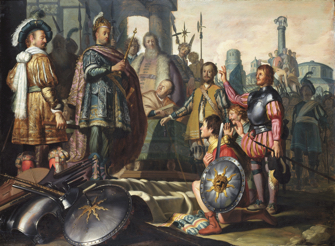
with their bright colors and many figures, but close study reveals touches of genius, like the gleaming armor and magnificently rendered clothing, right down to the plaid fabric tied around the knees of a dignitary, in “History Scene” (1626). In a way, this qualifies as another self-portrait, since Rembrandt painted himself into the work; his face can be seen behind the scepter of the king.
In the next room is another of the museum’s own Rembrandts, “Pilgrims at Emmaus” (c. 1629; pictured at the top of this page), which must have looked shockingly strange when he painted it in 1629, not long after he began using chiaroscuro effects in his works. Christ, shown in profile, is plunged in darkness, symbolizing the mystery of the resurrection. The light falls on the textured wall behind him and on the face of the pilgrim sitting across the table from him wearing a stunned expression. Through an open door in the background, we see the silhouette of a stooping servant wreathed in candlelight. In the foreground, another pilgrim, fallen to his knees at the moment of revelation, can barely be seen in the darkness. (The Louvre’s 1648 “Pilgrims at Emmaus” is also in this show.)
There are many more treasures here, including
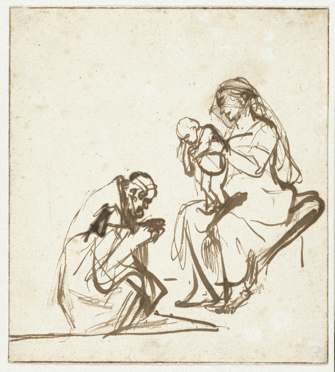
some of the master’s virtuoso drawings and paintings featuring his wife Saskia, his mistress Hendrickje Stoffels and his son Titus. In the huge, magnificent portrait called ”Old Man in Oriental Dress” (1632), the largest he ever painted, Rembrandt captured as he did so well
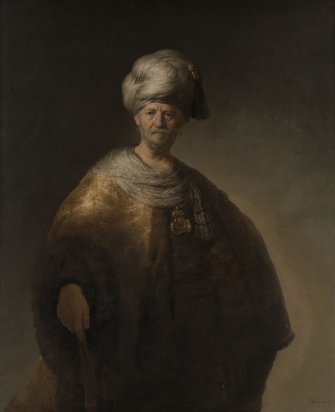
the golden glow of the subject’s glorious turban, robe and jewelry. The man’s aging face, with its decrepit skin and sagging eyes and chin, is just as carefully rendered, as if to say, “You may be rich and powerful now, but guess what’s coming!”
It was a lesson Rembrandt himself learned the hard way. He enjoyed his wealth and fame perhaps a bit too much, and nearly went bankrupt in 1656. He was forced to sell his possessions to pay off his creditors and had to move to a working-class neighborhood in Amsterdam. His companion Hendrickje Stoffels died of the plague in 1663, and he lost his son in 1668. When he himself died the following year, he was buried in an unmarked grave.
Favorite
